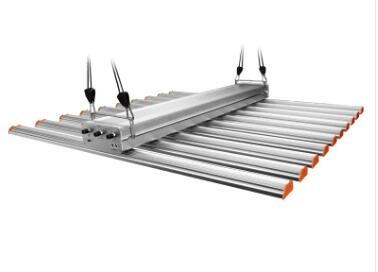What are the key components of an LED grow light fixture
2023-10-30
An LED (Light Emitting Diode) grow light fixture consists of several key components that work together to provide the necessary light spectrum and intensity for plant growth. These components include:
1. LED Diodes: LED diodes are the heart of the fixture and emit the light that plants use for photosynthesis. Different diodes are used to produce specific wavelengths of light, such as red and blue. Some fixtures may also incorporate white diodes to provide a full spectrum of light.
2. LED Drivers: LED drivers are electronic components that regulate the electrical current and voltage supplied to the LED diodes. They ensure the diodes receive the correct power for optimal performance.
3. Heat Sink: LED diodes can generate heat during operation. A heat sink, typically made of aluminum or another heat-conductive material, is used to dissipate this heat and prevent the diodes from overheating. Proper cooling is crucial for the longevity and performance of LED grow lights.
4. Optical Lenses or Reflectors: Some LED fixtures include optical lenses or reflectors to direct and focus the emitted light. These components help improve light uniformity and intensity in the target area, ensuring even plant coverage.
5. Housing or Enclosure: The housing or enclosure of the fixture protects the internal components and diodes. It often includes ventilation holes or fans for heat dissipation and may be designed to be waterproof or resistant to environmental conditions.
6. Mounting Hardware: LED grow lights come with various mounting options, such as hanging chains, brackets, or adjustable hangers, to securely install the fixture at the desired height and angle above the plants.
7. Power Cord and Plug: A power cord with a plug is provided to connect the fixture to an electrical outlet. The length of the cord may vary depending on the manufacturer and model.
8. Control Panel: Some LED grow lights feature a control panel that allows users to adjust light intensity, spectrum, and timing. This panel may include buttons, knobs, or a digital interface for programming and customization.
9. Dimmer or Controller: High-end LED grow light fixtures may include a dimmer or controller that enables growers to fine-tune the light output, create custom lighting schedules, and automate the lighting process.
10. Hanging Hardware: Fixtures designed for suspended installation come with hanging hardware, such as hooks and chains, to facilitate hanging at the appropriate height above the plants.
11. Power Supply: The power supply unit converts standard household electrical voltage into the specific voltage required by the LED driver and diodes. It is often integrated within the fixture or provided as an external component.
12. Power Switch: A power switch allows users to turn the fixture on and off as needed. Some fixtures have a built-in switch, while others rely on an external switch or socket.
13. Light Emitting Surface: This is the area where the LED diodes are mounted and where the light is emitted. The size and arrangement of the light-emitting surface can vary between different LED grow light models.
14. Remote Control (optional): Some advanced LED grow lights come with a remote control for adjusting settings, changing light modes, or setting up customized lighting schedules.
15. Smart Features (optional): Certain LED grow light models may include smart features, such as Wi-Fi connectivity or smartphone apps, which allow users to control and monitor the lighting remotely and integrate it with other automation systems.
The specific components and features of an LED grow light fixture can vary widely among different models and manufacturers. The choice of a fixture depends on the grower's specific needs, the type of plants being cultivated, and the growing environment.



